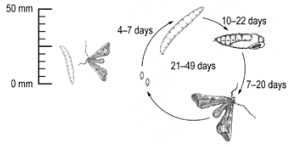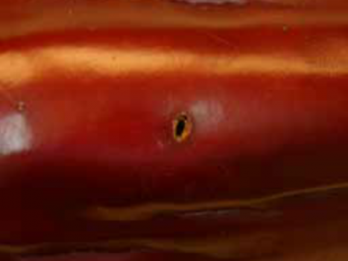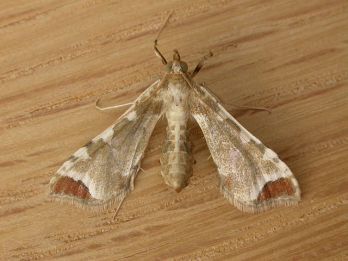Eggfruit caterpillar
The Eggfruit caterpillar (Sceliodes cordalis) is a pest targeting eggplant fruit and occasionally tomato, capsicum, and pepino fruit.
Background
Eggfruit caterpillars are found throughout Australia and New Zealand. They are active all year in warm areas but have a winter diapause in cold climates.
When mature, a single moth can lay 100 eggs in a night. Up to 2 eggs are laid on the calyx of each fruit and these hatch in 4 to 5 days.
Eggs and larvae are fed upon by generalist predators, including bugs, wasps, beetles, and spiders.
 Eggfruit caterpillar lifecycle
Eggfruit caterpillar lifecycle
Impacts
Eggfruit caterpillars burrow into the centre of fruit at the stem end. They feed on the developing seeds, causing fruit to break down and rot. Some larvae bore into the stem, causing the plant to wilt.
The damage caused is not apparent until either:
- the mature caterpillar tunnels out, leaving a 3 to 4mm exit hole
- the fruit is harvested and cut open.
Management
Monitor moth activity using light and pheromone traps.
- Check fruit for eggs, larvae, beneficial activity and feeding damage.
- Use foliar insecticides if necessary to control severe infestations. Time the applications for egg hatch and first-instar larvae. Choose selective chemistries such as Bacillus thuringiensis (Bt) to minimise harm to lepidopteran and other pest predators.
- In small plantings, physically remove eggs and larvae.
- Follow farm hygiene practices and destroy old crops when harvesting is completed, including weed hosts.
Identification
Eggfruit caterpillar eggs are creamy white, oval and dome shaped.
Newly hatched larvae have a colourless body with a brown head. As they mature, the larvae turn pink and have a smooth, glistening appearance. Fully grown caterpillars can reach 25mm long.
The adult moth has a wingspan of about 25mm. Wings are yellowish brown with transverse markings and the forewings have golden tips with black edges. At rest, they sit with the abdomen curled upwards.


